To understand US interest rates and how yield curve control works, it is critical to consider the effects of negative interest rates coupled with yield curve control, as already applied outside the US. We have written several times about the impact of negative interest rate policy (NIRP) on worldwide interest rates.
In the current pandemic circumstances, that issue is more important than ever, because many of the world’s central banks are engaged in monumentally expansive policy. The world is awash with central bank-created liquidity that flows among countries and regions. We have discussed some aspects of this policy in part 1 (https://www.cumber.com/cumberland-advisors-market-commentary-interest-rates-and-yield-curve-control-part-1/) and part 2 (https://www.cumber.com/cumberland-advisors-market-commentary-interest-rates-and-yield-curve-control-part-2/) of this series. Part 3 will focus on negative rates.
Some readers may recall our earlier discussion of how negative interest rates impact all yield curves and eventually force them into a parallel shape. We discussed why that happens and will embellish that discussion as part of this series on yield curve control. We have also discussed how the derivative process causes it to happen. That work was featured some time ago in a Bloomberg column by John Authers, and we thank John for that recognition (“We're Sensing Some Negativity About Sub-Zero Rates,” https://www.bloomberg.com/opinion/articles/2019-11-25/negative-interest-rates-are-hurting-financial-markets-k3dyrr8q).
Essentially, the starting point of the negative interest-rate policy is to cause the negative-rate yield curve to slope into more-negative rates as one extends maturities. The reverse happens with positive-rate yield curves. This creates a tension, and currency-hedged adjustments and derivatives eventually resolve that tension. As that resolution occurs, all yield curves gravitate toward a parallel slope. Furthermore, the yield spreads between various currency yield curves become the currency futures differentials. We will show this sequence over time.
Below is a series of charts that depict the negatively and positively sloped yield curves at various dates. We have noted key dates and events for reference, so that readers can recall the pertinent history. The bottom line is that we can follow the timeline of these yield curve shifts and see how many of them have reached a parallel shape today. When they have become parallel, it means that the different monetary policies of the countries involved have now been adjusted to nearly full alignment by market agents. The differentials in yields at a given maturity have come to be based on the market agents’ views of the rolling forward currency hedges we discussed in earlier parts of this series.
Of course, there is also an adjustment for creditworthiness, as one would expect. Please note the sequence of charts now ends at August 31 and captures market-based prices (yields) after Chair Powell’s policy-focused speech at the Fed’s Jackson Hole meeting.
The charts below tell the rest of the story. The first is a concept chart to show how spreads between maturities in two different currencies (one in NIRP and one in positive slope) start widening as maturities extend. That is where the tension begins, because the derivatives market wants to pull them into parallel and the currency futures market uses the shorter maturities (3 months or 6 months) to price the currency risk and then rolls it forward.
Chart 2 is an actual depiction of the euro in NIRP versus the US dollar in positive slope (January 2018). We start with this chart because it is the basis of a visual proof of concept using real market prices and a time period of two and a half years. The rest of the charts show yield curves in various currencies, with the snapshots taken at recognizable key dates. As you can see, all the yield curves are now nearly parallel (as of August 31, 2020). All slopes are in the same or similar term structures, and it makes no difference whether the short-maturity starting point is a negative short-term rate or a positive short-term rate.
We’ve purposefully included the American AAA-rated municipal bond yield curve. Note how the spread caused by US taxation has nearly disappeared. Foreign (crossover) buyers seek US dollar-denominated yields without regard to taxation. Thus an AAA sovereign state paying interest in US dollars is desirable when it yields more than a US Treasury bond does. As my colleague John Mousseau noted on our Monday morning call, we also see crossover buyers in Munis issued by prestigious higher education issuers that are respected and recognized worldwide. Notice how the tax arbitrage was working when the first COVID case was reported. Today, the spread between munis and Treasuries widens as maturity extends, but that is due to COVID-19 credit risk. It is these crossover buyers that bring the muni market into alignment with the Treasury market when muni yields are above Treasury yields.
Now to the charts. We’re working on Part 4.
David R. Kotok
Chairman of the Board & Chief Investment Officer
Email | Bio
[gallery link="file" size="medium" ids="53614,53613,53612,53611,53610,53609,53608,53607,53606,53605"]
Links to other websites or electronic media controlled or offered by Third-Parties (non-affiliates of Cumberland Advisors) are provided only as a reference and courtesy to our users. Cumberland Advisors has no control over such websites, does not recommend or endorse any opinions, ideas, products, information, or content of such sites, and makes no warranties as to the accuracy, completeness, reliability or suitability of their content. Cumberland Advisors hereby disclaims liability for any information, materials, products or services posted or offered at any of the Third-Party websites. The Third-Party may have a privacy and/or security policy different from that of Cumberland Advisors. Therefore, please refer to the specific privacy and security policies of the Third-Party when accessing their websites.
Sign up for our FREE Cumberland Market Commentaries
Cumberland Advisors Market Commentaries offer insights and analysis on upcoming, important economic issues that potentially impact global financial markets. Our team shares their thinking on global economic developments, market news and other factors that often influence investment opportunities and strategies.


